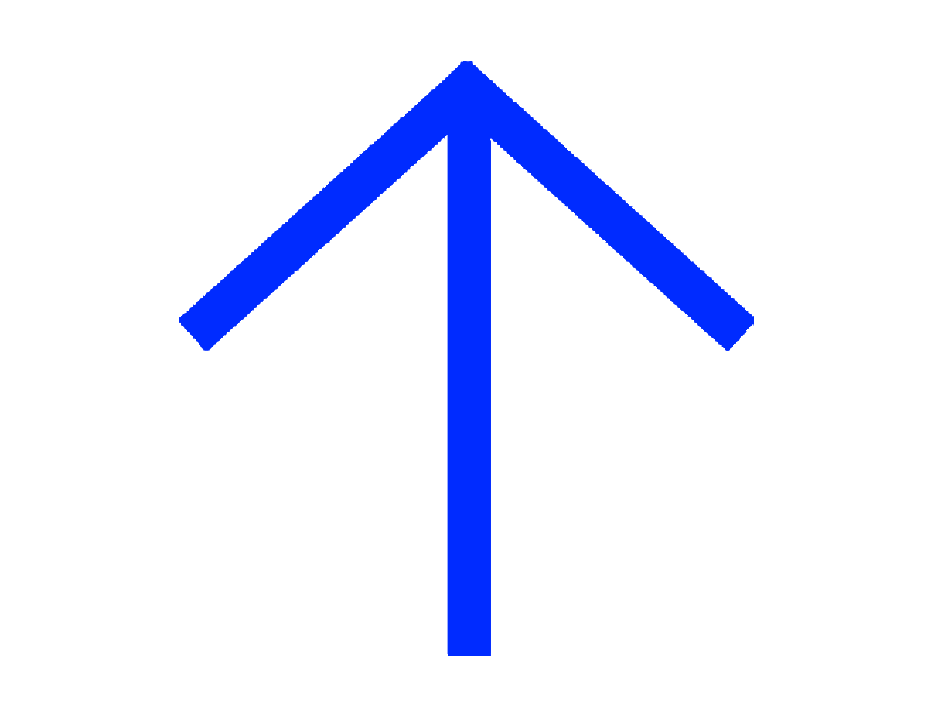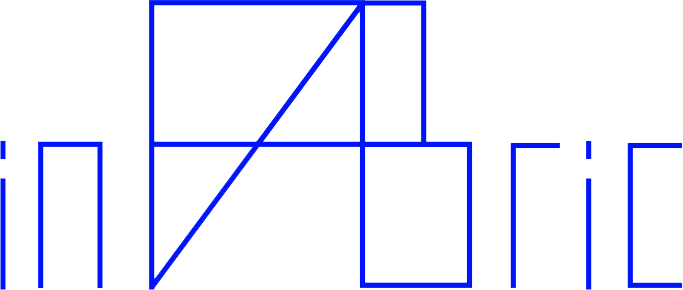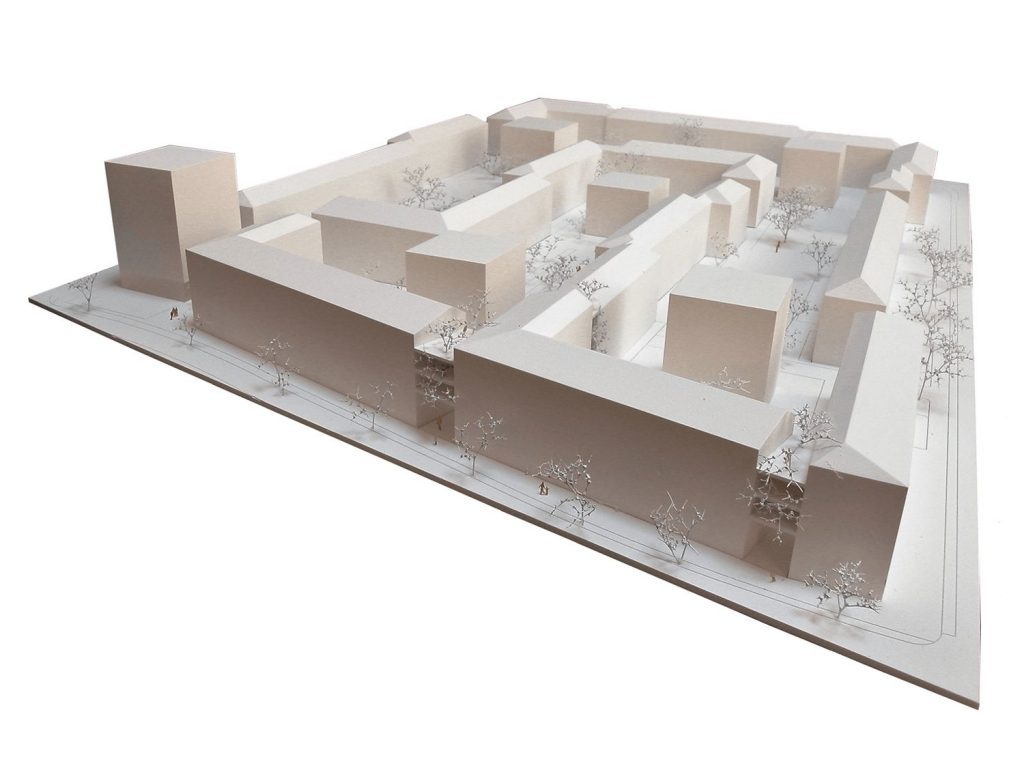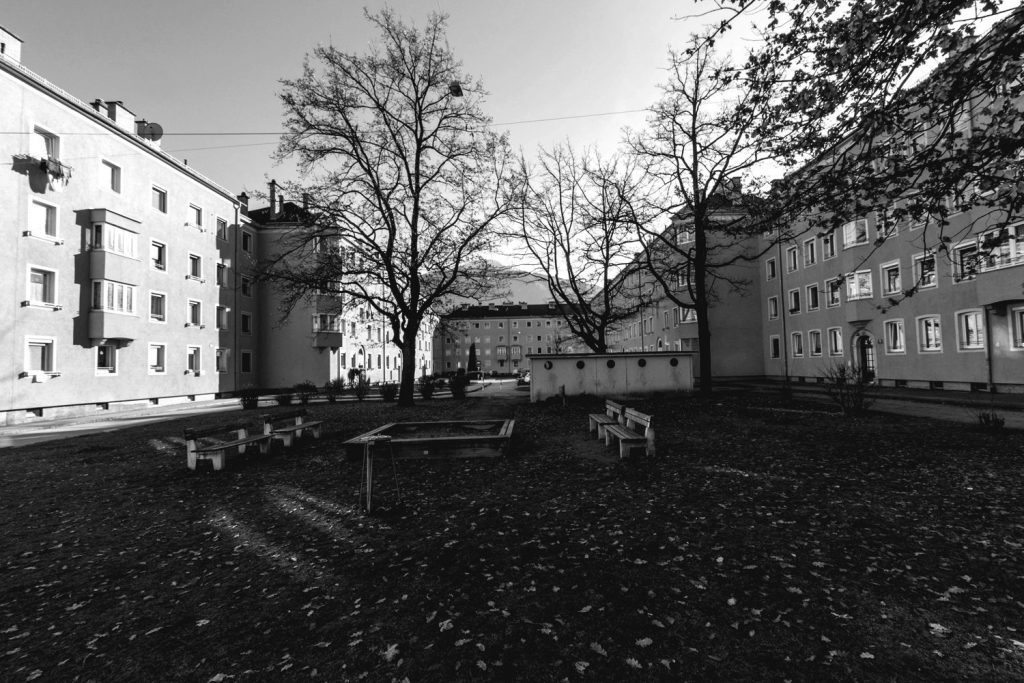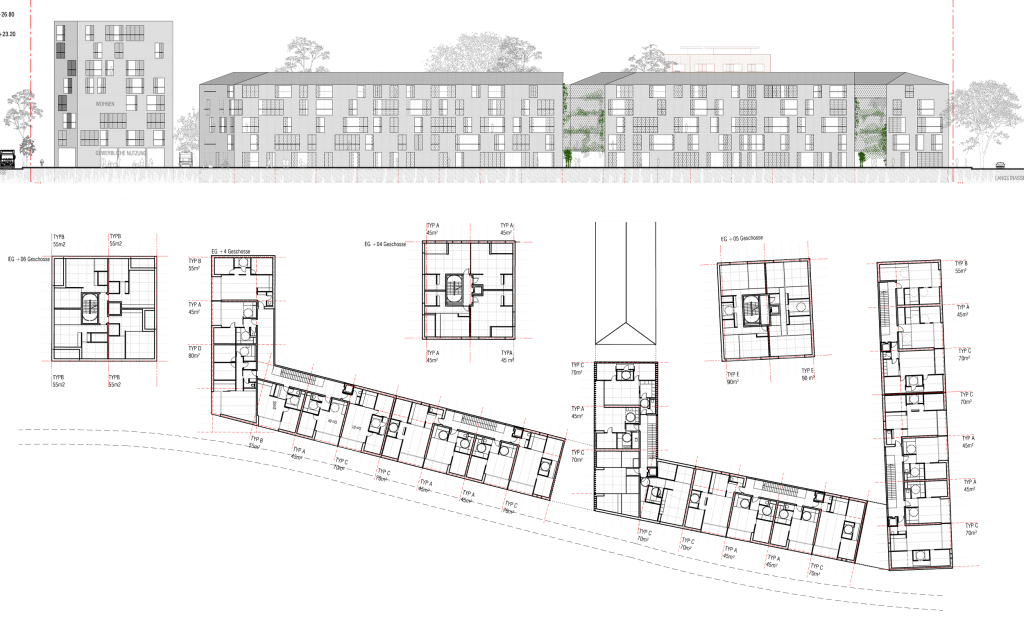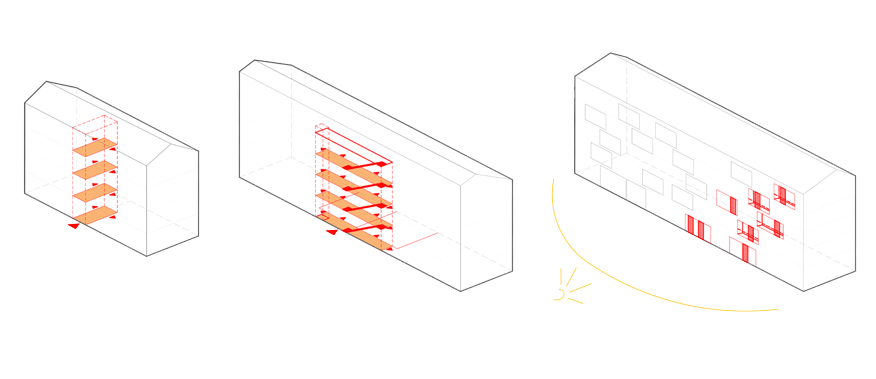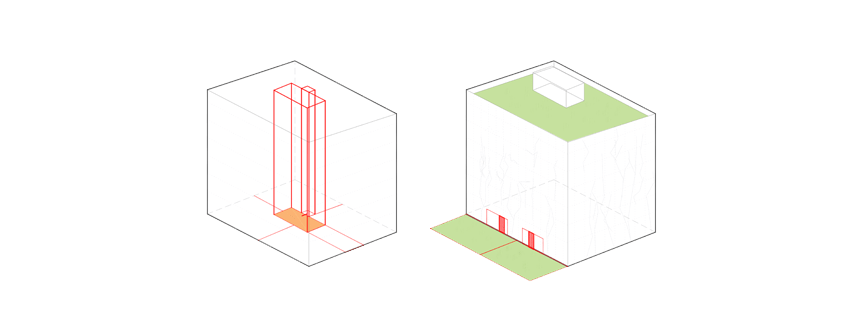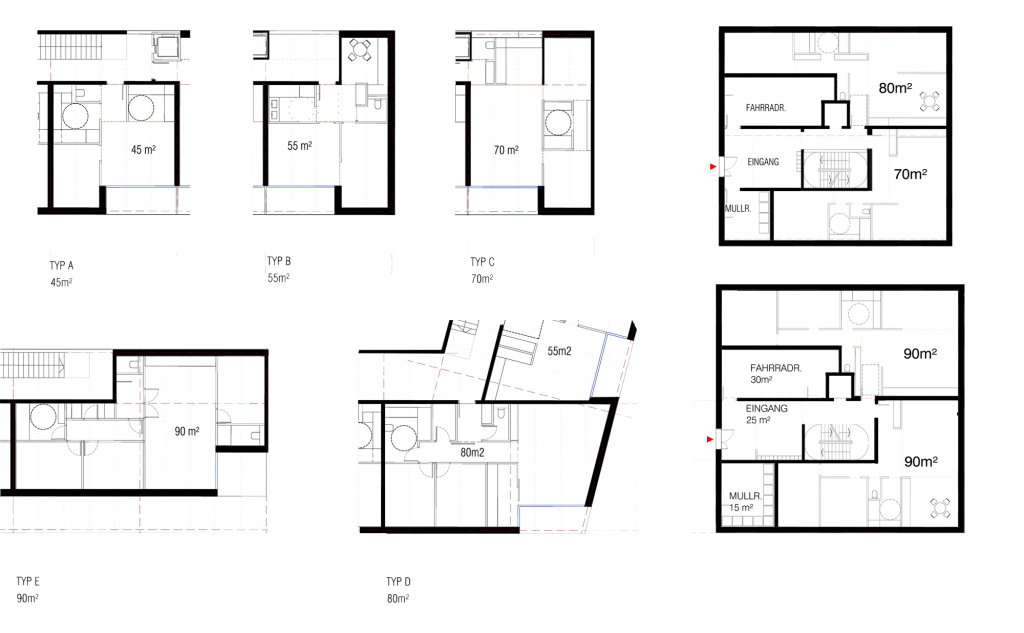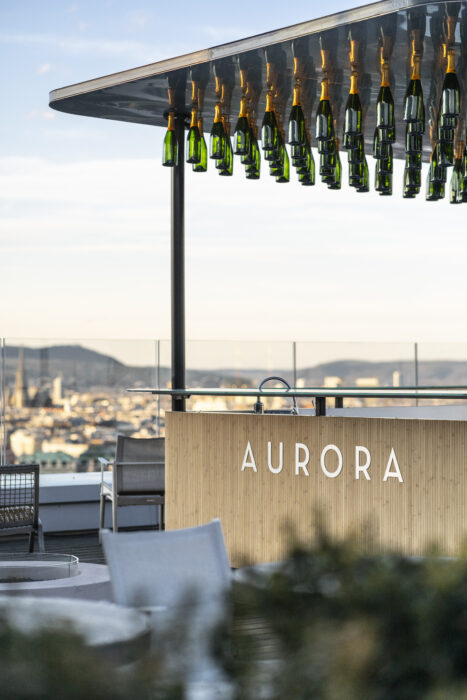Eichhof | Innsbruck | 2016
| Eichhof, Innsbruck (AT) |
| Wettbewerb 2016 |
| - | |
| BAUHERR: | Innsbruck Stadt |
| ARCHITEKT: | inFABric architectes, Maria Pfeiffer Landschaftarchitektur |
| PROGRAMM: | Renovierung und Erweiterung einer Wohnsiedlung, Gewerbe, Tiefgarage, Aussenanlage... |
| FLÄCHE: | 20 000 m² |
| TEAM: | Anita BARTHELEMY PEBOECK | Fabien BARTHELEMY | Sibylle PÖHLER | Kirsi MARJWAKI | Stefanie MATTHYS |
Das Eichhof-Areal ist im Norden, Süden und Westen von städtischer Blockrandbebauung umgeben, im Osten befindet sich eine weitere Südtiroler Siedlung, mit einer ebenfalls relativ geschlossenen Raumkante zum Eichhof hin. Es befindet sich so an einer wichtigen städtebaulichen Schnittstelle.
Grundidee ist es, die südliche Raumkante der Siedlung zu schließen und somit einen urbaneren und klareren Straßen Raum zur Kranewitterstrasse zu bilden. Dieses erfolgt durch zwei parallel gestellte L-förmige Baukörper sowie durch zwei punktförmige abschließende Gebäude, die im räumlich harmonischen Bezug zueinanderstehen.
Hierbei werden die wichtigsten Ideen der Südtiroler Siedlung aufgenommen und weiterentwickelt:
Öffentliche Durchwegungen und stellenweises Aufbrechen der strikten Blockrandbebauung mit begrünten Terrassen, Durchblicke auf die großzügigen und durchgängigen Grünräume vom Strassenraum aus und von Innenhof zu Innenhof.
Die Fortführung der bestehenden fußläufigen Durchwegungen schafft Durchlässigkeit, verbessert die Nahversorgung und verringert die Verkehrswege. Ein weiteres Merkmal des Konzeptes sind Durchgänge im Erdgeschoss, die nicht nur zur Vernetzung mit dem Quartier dienen, sondern auch als direkter Zugang in den Garten von den Treppenhäusern aus für alle Bewohner. Eine intelligente Wegführung des zentralen Freiraumes und grüne Pufferzonen unterstützen die Quartiersbildung und Identitätsstiftung für die Bewohner.
Lindenstrasse Ecke Kranewitterstrasse soll ein urbaner Hochpunkt mit einer urbanen Platzgestaltung entstehen, der auf das gegenüberliegende Gebäude und Platz mit Programm und Kubatur antwortet. Dieses Gebäude überschreitet 22m nicht. Ein Café im Erdgeschoss wäre vorstellbar. Der bestehende relativ ungefasste Platz dort wird dadurch städtebaulich verbessert. Durch die Höhe des Gebäudes wird er sichtbar und bekommt eine stärkere Identität.
In den Innenhöfen wird eine andere Typologie von Wohnhäusern vorgeschlagen: die Stadtvillen. Diese Häuser haben große private Außen Räume und sind vor allem für Familien vorgesehen, die von der Ruhe und den Qualitäten der Höfe profitieren. Die Stadtvillen bieten eine Alternative zum städtischen Wohnen. Die Begrünung der Fassaden und der niedrigen Höhe dieser Gebäude sorgt für eine gute Integrierung in ihre unmittelbare Umgebung. Eine Beschattungsstudie hat die Position dieser Gebäude bestimmt, sie sind so platziert, dass die den bestehenden Häusern kein Licht nehmen.
| Eichhof Innsbruck (AT) |
| concours 2016 |
| - | |
| MOA: | Ville de Innsbruck |
| MOE: | inFABric architectes, Maria Pfeiffer paysagiste |
| PROGRAMME: | Renovation et extension d'un ensemble de logements, commerces, parking amenagements exterieurs... |
| SURFACE: | 20 000 m² |
| TEAM: | Anita BARTHELEMY PEBOECK | Fabien BARTHELEMY | Sibylle PÖHLER | Kirsi MARJWAKI | Stefanie MATTHYS |
Le quartier Eichhof est un ensemble de logements construit vers 1940. Il est situé dans une zone dont la structure urbaine d‘Innsbruck commence à se fragmenter. 3 des bords de l ensemble sont alignés sur la rue, le 4e (au sud) reste ouvert.
Plutôt que de détruire et reconstruire à neuf, le parti est pris de conserver la plus grande partie de l‘existant et de poursuivre la construction de la ville par une densification de manière plus progressive et naturelle. Cela commence par la fermeture du 4e coté de l’ilot pour participer de manière claire à la densification du quartier de ville et au tracé des rues avoisinantes. Par ailleurs, une placette est réalisée à l’angle sud du terrain, en face du nœud ou se trouvent les transports urbains, les commerces, et crée une entrée animée à l’ensemble.
Les nouvelles constructions périphériques s’apparentent, par leur hauteur et profondeur à l’existant, tout en proposant des plans contemporains et une accessibilité pour tous.
Un deuxième de type de construction "villa urbaine" au plan carré et plus élevé que le reste de l'ensemble vient densifier les cours larges intérieures. Ces petits cubes sont positionnés en respect pour l’éclairement des constructions existantes et nouvelles et comportent de grands appartements familiaux profitant des généreux extérieurs des cours de l’ensemble Eichhof.
| Eichhof Innsbruck (AT) |
| competition 2016 |
| - | |
| CLIENT: | City of Innsbruck |
| ARCHITECT: | inFABric architectes, Maria Pfeiffer Landscape architecture |
| PROGRAMME: | Extension - renovation of a residential area, retail, parking, outside facilities... |
| SURFACE: | 20 000 m² |
| TEAM: | Anita BARTHELEMY PEBOECK | Fabien BARTHELEMY | Sibylle PÖHLER | Kirsi MARJWAKI | Stefanie MATTHYS |
The Eichhof site is surrounded to the north, south and west by urban perimeter block development, while to the east there is another South Tyrolean settlement, which also has a relatively closed spatial edge towards the Eichhof. It is therefore located at an important urban interface.
The basic idea is to close the southern edge of the settlement and thus create a more urban and clearer street space towards Kranewitterstrasse. This is achieved through two parallel L-shaped structures and two point-shaped buildings at the end, which relate to each other in a spatially harmonious way.
The most important ideas of the South Tyrolean settlement are taken up and further developed:
Public thoroughfares and, in places, breaking up the strict perimeter block development with landscaped terraces, views of the generous and continuous green spaces from the street and from courtyard to courtyard.
The continuation of the existing pedestrianised thoroughfares creates permeability, improves local amenities and reduces traffic routes. A further feature of the concept is the passageways on the ground floor, which not only serve to connect with the neighbourhood, but also provide direct access to the garden from the stairwells for all residents. Intelligent routing of the central open space and green buffer zones help to create a sense of neighbourhood and identity for the residents.
At the corner of Lindenstrasse and Kranewitterstrasse, an urban high point is to be created with an urban square design that responds to the opposite building and square with its programme and cubature. This building does not exceed 22 metres. A café on the ground floor would be conceivable. This would improve the urban design of the existing relatively undefined square. The height of the building makes it visible and gives it a stronger identity.
A different typology of residential buildings is proposed in the inner courtyards: urban villas. These houses have large private outdoor spaces and are primarily intended for families who benefit from the tranquillity and qualities of the courtyards. The urban villas offer an alternative to urban living. The greenery on the façades and the low height of these buildings ensure good integration into their immediate surroundings. A shading study has determined the position of these buildings, which are positioned in such a way that they do not take light away from the existing houses.
Tags: architecture austria competition housing innsbruck urbanism
